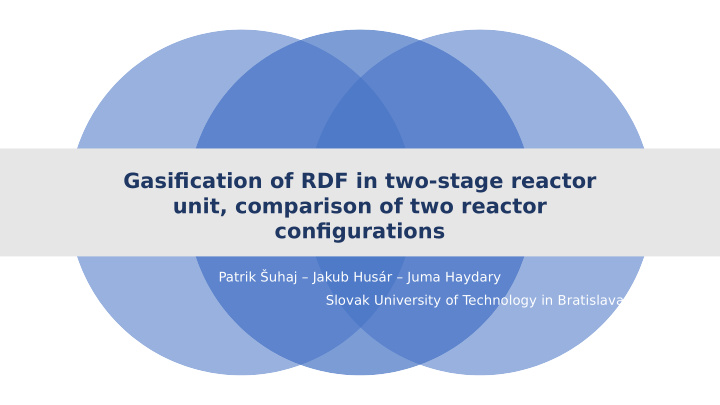



Gasifjcation of RDF in two-stage reactor unit, comparison of two reactor confjgurations Patrik Šuhaj – Jakub Husár – Juma Haydary Slovak University of T echnology in Bratislava
Introduction • RDF – Refuse derived fuel • Gasifjcation – syngas production • T ars – undesired product RDF characterisation Ultimate analysis (wt. Proximate analysis (wt. %) %) N 1,4 Ash 10 C 52 Moisture 4 H 8,2 Volatile matters 81 S 0,22 Fixed carbon 6 O 28 Cl 0,72 LHV (MJ/kg) 21,3
• Comparison of 2 reactor confjgurations Goals • Syngas composition • T ar yields
Syng Syng as as A Cataly Materials and en B tic methods reacto Catal Catal r yst yst • Idea: partial oxidation zone: air + volatiles = high Gasifying/pyr Ai temperature olysis r => lower tar content in reactor syngas RDF RDF Confjguration A Confjguration B Nitrogen Nitrog + Air
Syng Syng as as A Cataly Materials and en B tic methods reacto Catal Catal r yst yst • Semibatch process: 10 g sample of RDF, 10 g catalyst, Gasifying/pyr Ai 15 L/h N 2 , 10 L/h air. olysis r • Operating conditions: reactor temperature of reactors – 700, 750 RDF and 800 °C, RDF preheated catalytic reactor, preheated furnace for gasifying/pyrolysis reactor. • Catalyst: clay based catalyst enhanced by nickel oxide • Syngas composition (sampled at the Nitrogen Nitrog 5th minute) + Air • T ar yields – determined by vacuum distillation (10 kPa, 55 °C) and drying
Results Confjguration A Confjguration B T emperature (°C) 700 750 800 700 750 800 Gas Composition (vol. %) CO 2 38,8 38,7 36,9 40,9 27,1 17,3 H 2 27,8 25,0 18,2 24,5 31,2 41,0 CO 11,2 17,6 35,1 11,4 17,0 34,0 Methane 8,2 4,8 3,0 11,5 11,1 4,6 Hydrocarbons 14,0 14,0 6,9 12,4 13,7 2,9 T ar yields 15,4 14,4 9,19 15,5 14,4 5,61 [mg/g RDF]
A B • Efgect of partial oxidation on tar yields was obscured by activity of catalyst at 700 °C and 750 °C Conclusion • At 800 °C was observed drop of tar yield (comparison of confjgurations) and CO 2 and increased volume content of H 2 • Nickel oxide reduction by H 2 • H 2 /CO ratio above 2 at 700 °C • Pyrolysis coke – utilisation
Thank you for your attention
Recommend
More recommend